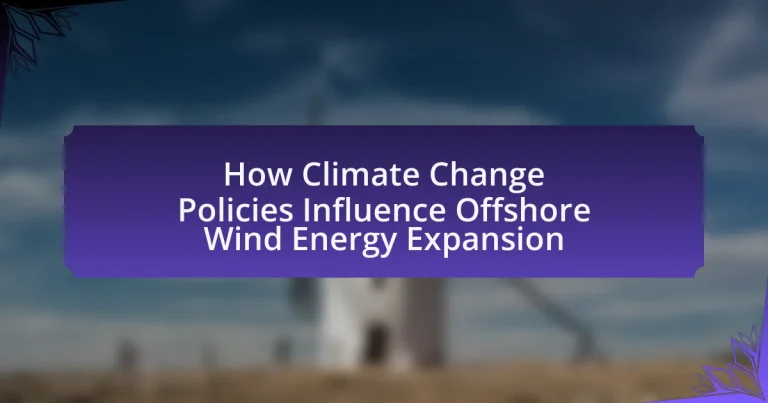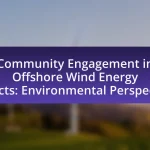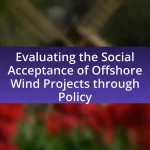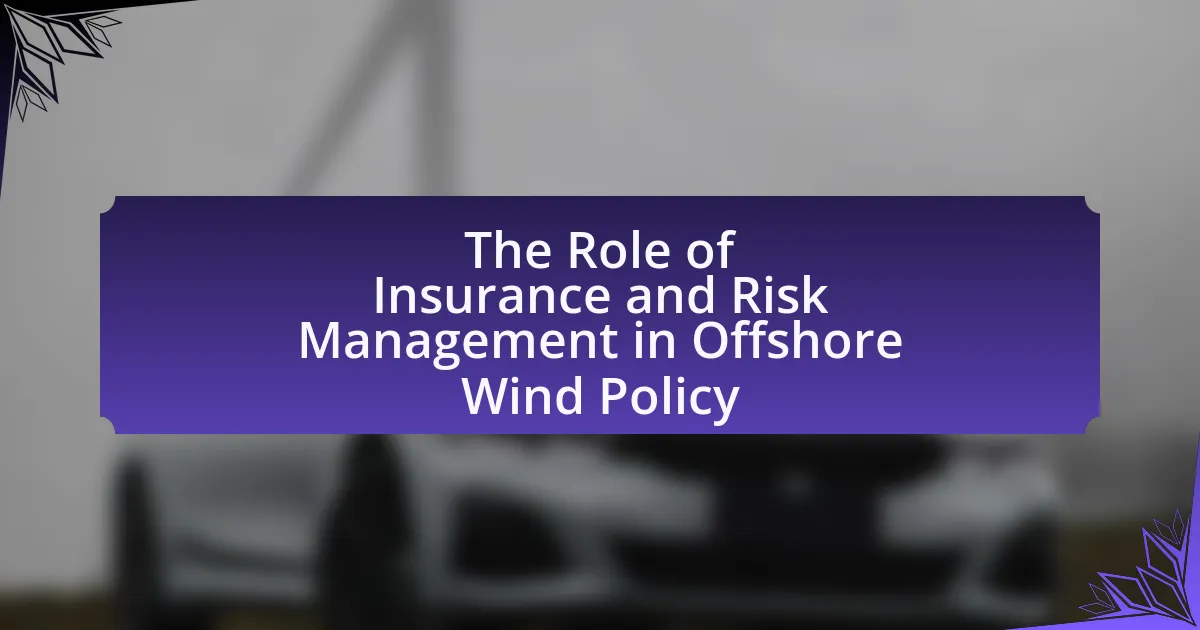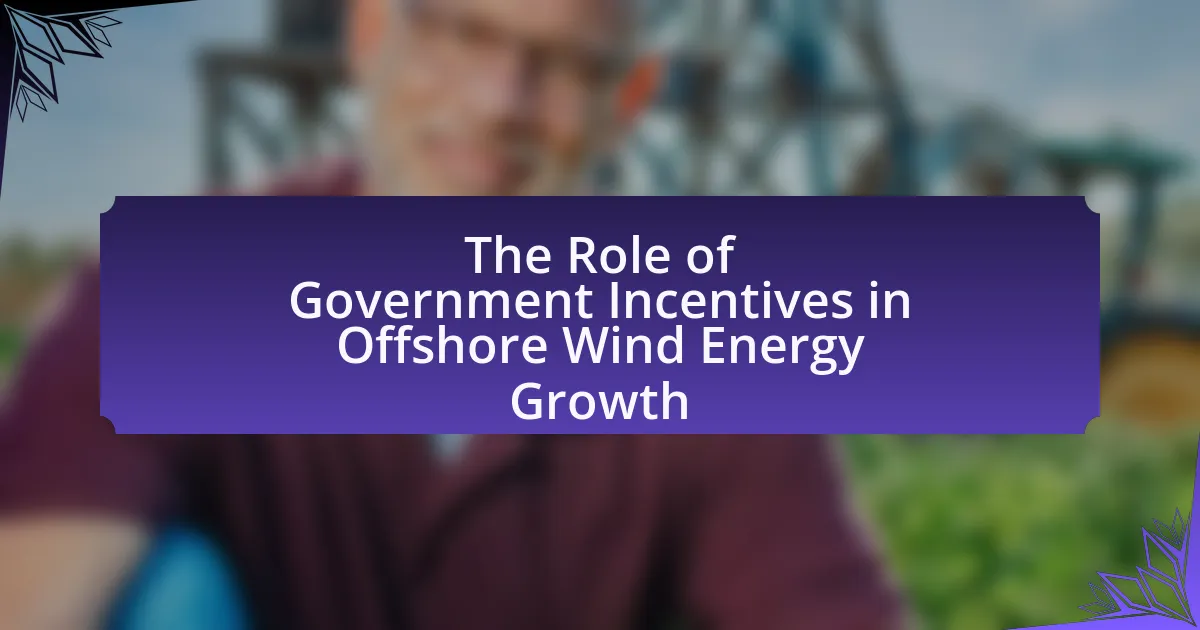Climate change policies play a crucial role in accelerating the expansion of offshore wind energy by establishing regulatory frameworks, financial incentives, and long-term commitments to renewable energy. Key policies, such as renewable energy mandates and carbon pricing mechanisms, promote investment in offshore wind projects, while international agreements like the Paris Agreement shape national initiatives. The article explores how national regulations, community engagement, and technological advancements influence the growth of offshore wind energy, highlighting the economic benefits and challenges faced in this sector. Additionally, it examines best practices from successful projects worldwide and the importance of public-private partnerships in facilitating offshore wind development.
How do climate change policies impact offshore wind energy expansion?
Climate change policies significantly accelerate offshore wind energy expansion by providing regulatory frameworks, financial incentives, and long-term commitments to renewable energy sources. These policies, such as the European Union’s Green Deal and the U.S. Inflation Reduction Act, set ambitious targets for reducing greenhouse gas emissions, which in turn create a favorable environment for investment in offshore wind projects. For instance, the U.S. aims to deploy 30 gigawatts of offshore wind energy by 2030, driven by federal support and state-level mandates. Such commitments not only enhance investor confidence but also stimulate technological advancements and infrastructure development, further facilitating the growth of the offshore wind sector.
What are the key climate change policies influencing offshore wind energy?
Key climate change policies influencing offshore wind energy include renewable energy mandates, carbon pricing mechanisms, and government incentives for clean energy projects. Renewable energy mandates, such as those established by the European Union and various U.S. states, require a certain percentage of energy to come from renewable sources, directly promoting offshore wind development. Carbon pricing mechanisms, like cap-and-trade systems, create financial incentives for reducing greenhouse gas emissions, making offshore wind a more attractive investment. Additionally, government incentives, including tax credits and grants, support the financial viability of offshore wind projects, facilitating their expansion. These policies collectively drive investment and innovation in the offshore wind sector, contributing to global efforts to combat climate change.
How do international agreements shape offshore wind energy initiatives?
International agreements significantly shape offshore wind energy initiatives by establishing binding commitments and frameworks for cooperation among countries. These agreements, such as the Paris Agreement, promote the transition to renewable energy sources, including offshore wind, by setting emission reduction targets and encouraging investment in clean technologies. For instance, the European Union’s Renewable Energy Directive mandates member states to increase their share of renewable energy, directly influencing national policies and funding for offshore wind projects. Additionally, international collaborations, like the North Sea Wind Power Hub initiative, facilitate shared infrastructure and technology development, enhancing the scalability and efficiency of offshore wind energy initiatives across borders.
What role do national regulations play in promoting offshore wind projects?
National regulations play a crucial role in promoting offshore wind projects by establishing a legal framework that facilitates development, investment, and operational standards. These regulations often include incentives such as tax credits, streamlined permitting processes, and renewable energy targets, which encourage private sector investment. For instance, countries like Germany and the United Kingdom have implemented specific policies that set ambitious offshore wind capacity targets, leading to significant increases in installed capacity. According to the International Renewable Energy Agency, the global offshore wind capacity reached 35 gigawatts in 2020, largely driven by supportive national policies.
Why is offshore wind energy considered a crucial component of climate change policies?
Offshore wind energy is considered a crucial component of climate change policies because it provides a significant source of renewable energy that can reduce greenhouse gas emissions. The International Energy Agency reports that offshore wind has the potential to generate over 18,000 terawatt-hours of electricity annually, which could meet a substantial portion of global energy demand while displacing fossil fuel use. This transition to renewable energy sources is essential for achieving international climate targets, such as those outlined in the Paris Agreement, which aims to limit global warming to well below 2 degrees Celsius.
How does offshore wind energy contribute to reducing greenhouse gas emissions?
Offshore wind energy significantly reduces greenhouse gas emissions by generating electricity without burning fossil fuels. This clean energy source displaces the need for coal, natural gas, and oil, which are major contributors to carbon dioxide and other greenhouse gases. According to the Global Wind Energy Council, in 2020, offshore wind energy helped avoid approximately 200 million tons of CO2 emissions globally. By harnessing wind power, offshore wind farms contribute to a cleaner energy mix, thereby playing a crucial role in mitigating climate change and supporting international climate goals.
What are the economic benefits of investing in offshore wind energy?
Investing in offshore wind energy generates significant economic benefits, including job creation, increased energy independence, and long-term cost savings. The offshore wind sector is projected to create over 200,000 jobs in the United States by 2030, according to the U.S. Department of Energy. Additionally, offshore wind projects can reduce reliance on fossil fuels, enhancing energy security and stabilizing energy prices. The levelized cost of energy from offshore wind has decreased by 70% since 2009, making it increasingly competitive with traditional energy sources. These factors collectively contribute to a robust economic framework that supports sustainable growth and resilience against climate change impacts.
What challenges do climate change policies face in promoting offshore wind energy?
Climate change policies face several challenges in promoting offshore wind energy, primarily including regulatory hurdles, financial constraints, and public opposition. Regulatory hurdles arise from complex permitting processes that can delay project development; for instance, in the United States, the Bureau of Ocean Energy Management has faced criticism for lengthy approval timelines. Financial constraints are evident as high initial capital costs deter investment; according to the International Renewable Energy Agency, offshore wind projects require significant upfront investment, which can be a barrier in regions with limited funding. Public opposition often stems from concerns about environmental impacts and visual aesthetics, which can lead to community pushback against proposed projects, as seen in various cases across Europe. These challenges collectively hinder the effective implementation of climate change policies aimed at expanding offshore wind energy.
How do regulatory hurdles affect project development timelines?
Regulatory hurdles significantly delay project development timelines by imposing lengthy approval processes and compliance requirements. These hurdles can extend the time needed to secure permits, conduct environmental assessments, and meet safety regulations, often resulting in project delays of several months to years. For instance, a study by the National Renewable Energy Laboratory found that regulatory delays can add up to 30% to the overall timeline of offshore wind projects, impacting investment and planning.
What are the environmental concerns associated with offshore wind energy expansion?
The environmental concerns associated with offshore wind energy expansion include impacts on marine ecosystems, bird and bat mortality, and potential disruption of fishing activities. Marine ecosystems can be affected by the construction and operation of wind farms, which may alter habitats and affect species distribution. Studies indicate that the installation of turbines can lead to increased mortality rates for birds and bats due to collisions. Additionally, offshore wind projects can interfere with fishing grounds, potentially leading to economic impacts for local fishing communities. These concerns highlight the need for careful planning and environmental assessments to mitigate negative effects while promoting renewable energy development.
How do specific climate change policies facilitate offshore wind energy growth?
Specific climate change policies facilitate offshore wind energy growth by providing financial incentives, regulatory frameworks, and long-term commitments that encourage investment in renewable energy infrastructure. For instance, policies such as feed-in tariffs and renewable energy certificates create guaranteed revenue streams for offshore wind projects, making them more attractive to investors. Additionally, streamlined permitting processes reduce bureaucratic hurdles, allowing projects to progress more quickly. According to the International Renewable Energy Agency, countries with robust climate policies have seen a significant increase in offshore wind capacity, with global installed capacity reaching over 35 gigawatts by 2020, driven largely by supportive government initiatives.
What incentives are provided for offshore wind energy projects?
Offshore wind energy projects receive various incentives, including federal tax credits, grants, and state-level support. The Investment Tax Credit (ITC) allows developers to deduct a significant percentage of the investment cost from their federal taxes, which has been crucial in making projects financially viable. Additionally, the Production Tax Credit (PTC) provides a per-kilowatt-hour tax credit for electricity generated by qualified offshore wind facilities. States often offer Renewable Energy Certificates (RECs) and other financial incentives to promote local development, further enhancing the economic feasibility of these projects. These incentives collectively aim to accelerate the transition to renewable energy and reduce greenhouse gas emissions, aligning with climate change policies.
How do tax credits and subsidies influence investment in offshore wind energy?
Tax credits and subsidies significantly enhance investment in offshore wind energy by reducing the financial risks and improving the economic viability of projects. These financial incentives lower the overall cost of development, making it more attractive for investors to commit capital. For instance, the Investment Tax Credit (ITC) in the United States allows developers to deduct a percentage of the investment cost from their federal taxes, which can lead to substantial savings. According to the U.S. Department of Energy, projects that benefit from such incentives can see returns on investment increase by up to 30%. Additionally, subsidies can provide guaranteed revenue streams through mechanisms like power purchase agreements, further encouraging investment by ensuring a stable income for developers.
What financing mechanisms are available for offshore wind energy developers?
Offshore wind energy developers have access to several financing mechanisms, including government grants, tax incentives, power purchase agreements (PPAs), and green bonds. Government grants, such as those from the U.S. Department of Energy, provide direct funding to support project development. Tax incentives, like the Investment Tax Credit (ITC) and the Production Tax Credit (PTC), reduce the overall tax burden for developers, making projects more financially viable. Power purchase agreements allow developers to secure long-term contracts with utilities, ensuring a stable revenue stream. Additionally, green bonds are increasingly used to raise capital specifically for environmentally sustainable projects, including offshore wind. These mechanisms collectively enhance the financial feasibility of offshore wind projects, facilitating their growth in response to climate change policies.
How do local and regional policies support offshore wind energy initiatives?
Local and regional policies support offshore wind energy initiatives by providing regulatory frameworks, financial incentives, and infrastructure development. These policies often include streamlined permitting processes that reduce bureaucratic delays, enabling faster project approvals. For instance, states like Massachusetts and New York have implemented specific legislation that prioritizes offshore wind development, setting ambitious renewable energy targets and establishing dedicated funds for project financing. Additionally, local governments may offer tax breaks or subsidies to attract investment in offshore wind projects, which can significantly lower the cost of development. According to the National Renewable Energy Laboratory, such supportive policies have been instrumental in increasing offshore wind capacity in the United States, with a projected growth from 42 megawatts in 2020 to over 30,000 megawatts by 2030, demonstrating the effectiveness of these local and regional initiatives.
What zoning regulations impact the development of offshore wind farms?
Zoning regulations that impact the development of offshore wind farms include federal, state, and local guidelines that dictate where and how these projects can be constructed. The Bureau of Ocean Energy Management (BOEM) oversees federal leasing and environmental assessments, while state agencies establish specific siting criteria, such as distance from shore, environmental impact assessments, and navigational safety. For example, Massachusetts has implemented a comprehensive offshore wind siting process that includes stakeholder engagement and environmental reviews, ensuring that projects align with both state energy goals and local community interests. These regulations are crucial for balancing renewable energy development with environmental protection and community concerns.
How do community engagement strategies affect policy implementation?
Community engagement strategies significantly enhance policy implementation by fostering collaboration between policymakers and local stakeholders. When communities are actively involved in the decision-making process, they are more likely to support and adhere to policies, as evidenced by studies showing that inclusive engagement leads to higher compliance rates and successful outcomes. For instance, research conducted by the International Association for Public Participation highlights that projects with strong community involvement experience a 30% increase in implementation success compared to those without such engagement. This demonstrates that effective community engagement not only builds trust but also aligns policy objectives with local needs, ultimately facilitating smoother and more effective policy execution.
What future trends can be expected in offshore wind energy due to climate change policies?
Future trends in offshore wind energy due to climate change policies include increased investment in technology and infrastructure, enhanced regulatory frameworks, and a shift towards larger and more efficient wind turbines. Governments worldwide are committing to net-zero emissions targets, which drives the demand for renewable energy sources like offshore wind. For instance, the European Union aims to increase its offshore wind capacity to 300 GW by 2050, reflecting a significant policy push. Additionally, advancements in floating wind technology are expected to expand deployment into deeper waters, making previously inaccessible areas viable for energy generation. These trends are supported by the growing recognition of offshore wind as a key component in achieving climate goals, evidenced by the International Energy Agency’s report indicating that offshore wind capacity could reach 234 GW by 2030 under current policy trajectories.
How are technological advancements shaping offshore wind energy policies?
Technological advancements are significantly shaping offshore wind energy policies by enhancing efficiency, reducing costs, and increasing energy output. Innovations such as larger turbine designs, improved materials, and advanced predictive analytics have led to higher capacity factors and lower levelized costs of energy (LCOE). For instance, the deployment of turbines with capacities exceeding 10 megawatts has been shown to increase energy generation potential, prompting policymakers to revise regulations and incentives to support larger projects. Additionally, advancements in floating wind technology allow for installations in deeper waters, expanding the geographical scope for offshore wind farms and influencing policy frameworks to accommodate these new technologies. As a result, countries are adapting their energy policies to promote investment in offshore wind, aligning with climate change goals and renewable energy targets.
What innovations are emerging in offshore wind turbine design?
Innovations in offshore wind turbine design include larger rotor diameters, floating turbine technology, and advanced materials for enhanced durability. Larger rotor diameters, which can exceed 200 meters, increase energy capture efficiency by harnessing more wind energy. Floating turbine technology allows for installation in deeper waters, expanding the potential sites for wind farms and enabling access to stronger winds. Additionally, the use of advanced materials, such as carbon fiber and lighter composites, improves the structural integrity and reduces the weight of turbines, facilitating easier installation and maintenance. These innovations are driven by the need for more efficient and sustainable energy solutions in response to climate change policies that promote renewable energy sources.
How does digital technology enhance the efficiency of offshore wind farms?
Digital technology enhances the efficiency of offshore wind farms by enabling real-time monitoring and predictive maintenance of turbines. This technology utilizes sensors and data analytics to track performance metrics, allowing for timely interventions that reduce downtime and optimize energy output. For instance, a study by the National Renewable Energy Laboratory found that predictive maintenance can increase turbine availability by up to 10%, significantly boosting overall energy production. Additionally, digital platforms facilitate better integration of renewable energy into the grid, improving energy management and reducing operational costs.
What role do public-private partnerships play in offshore wind energy expansion?
Public-private partnerships (PPPs) are crucial for the expansion of offshore wind energy as they leverage resources, expertise, and risk-sharing between the public and private sectors. These collaborations facilitate investment in large-scale projects, enabling the development of infrastructure and technology necessary for offshore wind farms. For instance, in the United Kingdom, the government has partnered with private companies to create a supportive regulatory framework and financial incentives, resulting in a significant increase in offshore wind capacity, which reached over 10 gigawatts by 2020. This model not only accelerates project timelines but also enhances innovation and reduces costs, making offshore wind energy more competitive in the energy market.
How can collaboration between governments and private sectors accelerate project development?
Collaboration between governments and private sectors can accelerate project development by leveraging resources, expertise, and regulatory support. Governments can provide funding, policy frameworks, and infrastructure, while private sectors contribute innovation, efficiency, and investment. For instance, the partnership between the U.S. Department of Energy and private companies in offshore wind projects has led to significant advancements in technology and reduced costs, as evidenced by the 70% decrease in the cost of offshore wind energy since 2009. This synergy not only speeds up project timelines but also enhances the overall effectiveness of climate change initiatives.
What best practices can be adopted from successful offshore wind projects worldwide?
Successful offshore wind projects worldwide demonstrate several best practices that can be adopted, including robust stakeholder engagement, comprehensive environmental assessments, and innovative financing models. Stakeholder engagement ensures that local communities, governments, and industry players are involved in the planning and decision-making processes, which has been shown to reduce conflicts and enhance project acceptance, as evidenced by the success of the Hornsea Project in the UK. Comprehensive environmental assessments, as practiced in the Block Island Wind Farm in the US, help identify and mitigate potential ecological impacts, ensuring sustainable development. Additionally, innovative financing models, such as those utilized in the Danish offshore wind sector, leverage public-private partnerships and government incentives to reduce financial risks and attract investment, leading to more successful project implementations.
What are the best practices for stakeholders in offshore wind energy development?
The best practices for stakeholders in offshore wind energy development include early and continuous engagement with local communities, transparent communication, and collaboration with regulatory bodies. Engaging local communities from the outset helps to build trust and address concerns, which is crucial for project acceptance. Transparent communication ensures that stakeholders are informed about project developments and potential impacts, fostering a sense of inclusion. Collaboration with regulatory bodies is essential to navigate the complex permitting processes and ensure compliance with environmental standards. These practices are supported by studies indicating that stakeholder engagement significantly enhances project success rates and community support, as evidenced by the successful implementation of offshore wind projects in countries like Denmark and the United Kingdom.
